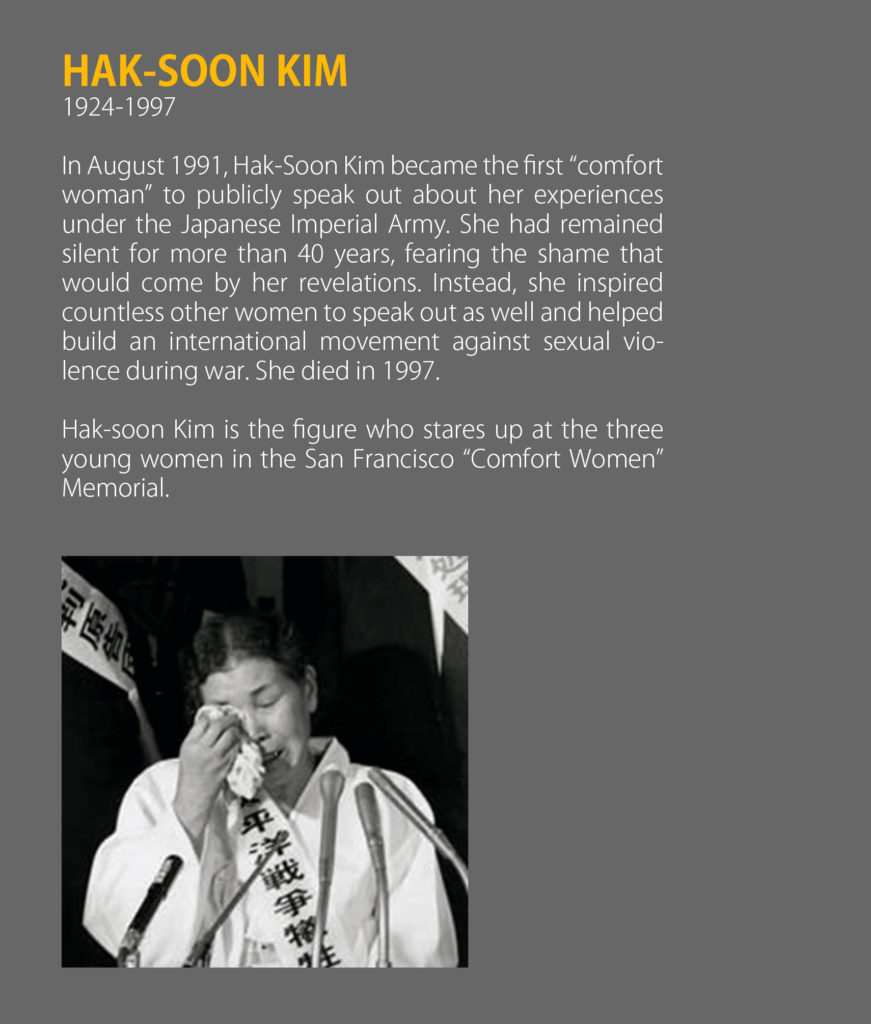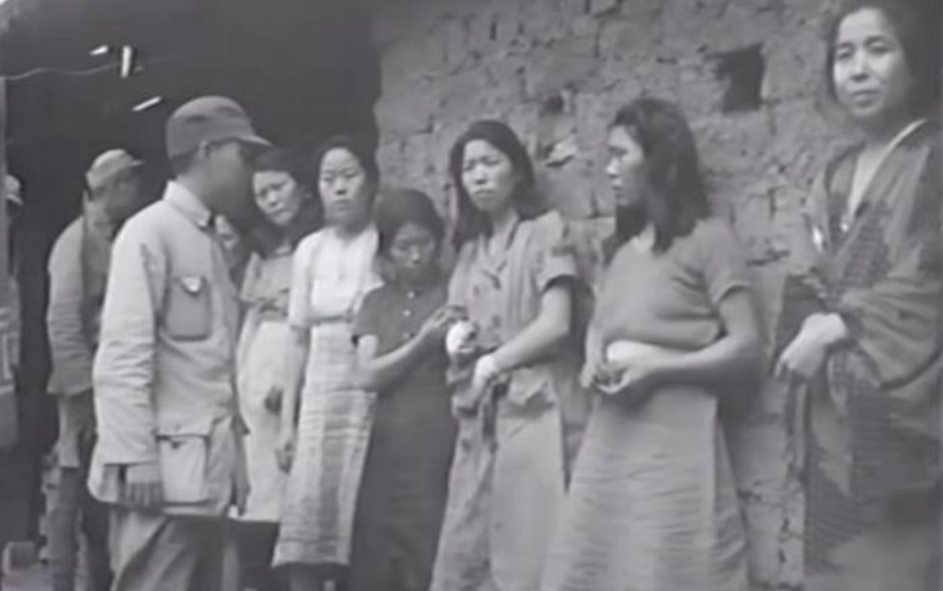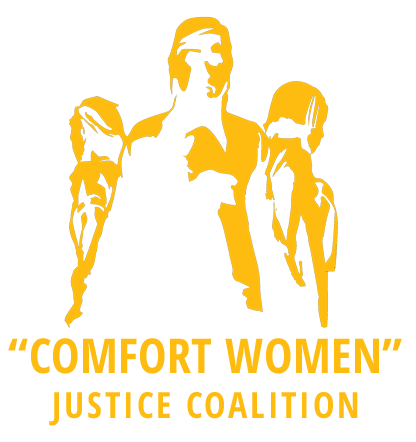
The term “Comfort Women” is a euphemism for sex slaves from the 1930s throughout the duration of World War II, when Japan invaded its neighboring countries. The Imperial Japanese Army engaged in the systemic trafficking of hundreds of thousands of girls and young women, with the majority from Korea, China, the Philippines, Indonesia (then Dutch East Indies) and forced them into sexual servitude for the Japanese soldiers. These women served anywhere from 5-60 soldiers a day resulting in a fatality rate of approximately 87%, compared to 27% of front line Japanese combatant soldiers (Qiu, Peipei, Zhiliang, Su, and Lifei, 2014).
House Resolution 121, unanimously passed at the US Congress in 2007, notes the “Comfort Women” system is “considered unprecedented in its cruelty and magnitude, included gang rape, forced abortions, humiliation, and sexual violence resulting in mutilation, death, or eventual suicide in one of the largest cases of human trafficking in the 20th century.” Historians state that this is the single largest case of institutionalized sexual exploitation committed by a government entity (Japan) in modern history.
Sexual violence and rape against women and children during military conflict are “crimes against humanity.” To this day, the Japanese government has not issued an official (cabinet- approved or ratified by the Diet), unequivocal and direct apology to the survivors of the “Comfort Women” system. On December 28, 2015, the foreign ministers of Japan and South Korea held a joint press conference in which each foreign minister made an announcement, respectively, wherein Japanese Prime Minister Shinzo Abe expressed “apology and remorse” without acknowledging the legal responsibility of the Japanese government and promised to donate approximately $8.3 million to the S. Korean government to set up a foundation that would “assist” the “Comfort Women” victims. The Japanese government made clear that the monies should never be directly distributed to the victims or their families because direct payment would mean legal compensation. In turn, the South Korean government would remove the “Comfort Women” memorial statue from in front of the Japanese Embassy in Seoul and never again bring up the issue of “Comfort Women” in the international community, including the United Nations. Further, that the South Korean government would acknowledge that the “Comfort Women” issue is “resolved finally and irreversibly.”
The “Comfort Women” survivors and their supporters around the globe immediately rejected the “so-called agreement”; decrying it as a “backdoor deal and a sellout” that completely ignored the voices and demands of the victims. Prominent “Comfort Woman” survivor turned activist Grandma Lee stated, “This agreement seems to have been made without having the victims in mind. I dismiss it in its entirety.”
Citation: Qiu, Peipei, Zhiliang, Su, and Lifei, Chen. Chinese Comfort Women. Vancouver, CA: UBC Press, 2014.
Below is a list of resources you can reference to learn more about this issue:
The issue
 UN Human Rights Reports
UN Human Rights Reports
Government Resolutions
Websites
 Video Resources
Video Resources
“Comfort Women” is the Japanese Imperial government’s euphemism for the women and children they trafficked as sex slaves between 1932 and 1945, until the end of World War II. Most of the victims were Korean and Chinese, although many others were from the Philippines, Indonesia, the Netherlands, Burma, Thailand, Vietnam, Malaysia, Australia, East Timor, Hong Kong, and Macau. While some were recruited by false advertisements promising work as house maids, factory workers and nurses, the majority were abducted and violently coerced into sexual slavery for Japanese soldiers at government sponsored “comfort stations” intended to improve army morale, as a strategy of war. It is estimated that some 400,000 women and children were forced to be sex slaves for Japanese soldiers and officers at these government-sponsored rape camps. The “Comfort Women” were often kept in subhuman conditions and suffered from starvation, physical and psychological abuse, disease, infections, and rampant STD’s. Many committed suicide.
Only about 10 to 25% of the victims survived the end of the war. Many had already died from their conditions and many more were executed before Allied troops would be able to find evidence of their existence. At the end of the war, the Japanese government attempted to destroy all documentation and evidence that the “Comfort Women” had ever existed. The “Comfort Women” were massacred in many locations. The survivors returned home bearing heavy burdens of psychological distress, physical ailments, and shame. Many others remained where the “Comfort Station” was located due to the lack of means to return, or out of shame and fear of the discrimination they may face back home. Many lived out their days ostracized from family and community. Not until the 1990’s did their stories begin to surface publicly.
In 1991, Hak-soon Kim, a Korean “Comfort Women”, became the first to share her story publicly. That year, the Japanese government publicly acknowledged that “Comfort Women” stations did exist during World War II. In 1993, Chief Cabinet Secretary Yohei Kono announced the Kono Statement, partially acknowledging the Japanese military’s involvement in the establishment, management and transfer of the extensive existence of the “Comfort Station” system. However, the Japanese government has never fully acknowledged or accepted the legal responsibility for this institutionalized military sexual slavery and the largest case of human trafficking of women for sexual servitude in the 20th century. Since that time, especially during the governance of Japan by Prime Minister Abe Shinzo, there has been continuous disagreement and unrest between the Japanese government and the victim communities about coming to a fair and just terms of resolution. Gradually, monuments for the “Comfort Women” are being built around the world to memorialize the victims and their communities and to educate new generations of the dangers of warfare and a global responsibility to protect human rights.
